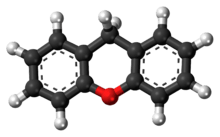Xanthene
Not to be confused with xanthine.
 | |
 | |
| Names | |
|---|---|
| IUPAC name
9H-Xanthene | |
| Other names
Dibenzo[a,e]pyran 10H-9-oxaanthracene | |
| Identifiers | |
| 92-83-1 | |
| 3D model (Jmol) | Interactive image |
| ChEBI | CHEBI:10057 |
| ChEMBL | ChEMBL486760 |
| ChemSpider | 6840 |
| ECHA InfoCard | 100.001.996 |
| EC Number | 202-194-4 |
| PubChem | 7107 |
| |
| |
| Properties | |
| C13H10O | |
| Molar mass | 182.22 g·mol−1 |
| Appearance | Yellow solid |
| Melting point | 101 to 102 °C (214 to 216 °F; 374 to 375 K)[1] |
| Boiling point | 310 to 312 °C (590 to 594 °F; 583 to 585 K)[1] |
| Hazards | |
| R-phrases | R42 R43 |
| S-phrases | S22 S36 S37 S45 |
| Except where otherwise noted, data are given for materials in their standard state (at 25 °C [77 °F], 100 kPa). | |
| | |
| Infobox references | |
Xanthene (9H-xanthene, 10H-9-oxaanthracene) is a yellow organic heterocyclic compound. Its chemical formula is C13H10O. It is soluble in diethyl ether. Its melting point is 101-102 °C and its boiling point is 310-312 °C. Xanthene is used as a fungicide and it is also a useful intermediate in organic synthesis.
Derivatives of xanthene are commonly referred to collectively as xanthenes, and among other uses are the basis of a class of dyes which includes fluorescein, eosins, and rhodamines. Xanthene dyes tend to be fluorescent, yellow to pink to bluish red, brilliant dyes. Many xanthene dyes can be prepared by condensation of derivates of phthalic anhydride with derivates of resorcinol or 3-aminophenol.
See also
References
- 1 2 Xanthene at Sigma-Aldrich
This article is issued from Wikipedia - version of the 6/14/2016. The text is available under the Creative Commons Attribution/Share Alike but additional terms may apply for the media files.